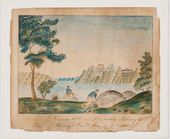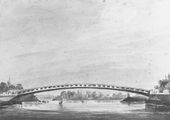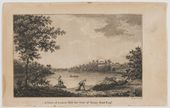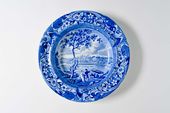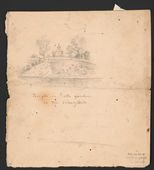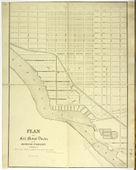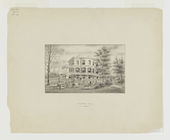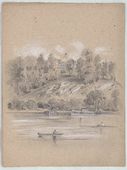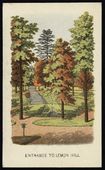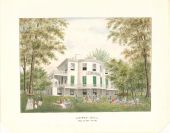Lemon Hill
See also: The Hills, Springettsbury
Lemon Hill (1799–1800) is one of the nation's finest examples of Federal-style architecture. Situated on a spectacular site overlooking the Schuylkill River in Philadelphia's Fairmount Park, it is a fitting testament to Philadelphia's apogee as a cultural and political center in the post-revolutionary era.
Overview
Alternate Names: Pratt's Gardens (after 1847)
Site Dates: 1799–1855
Site Owner(s): Henry Pratt (1761–1838)
Associated People: John McAran (landscape gardener), Robert Buist (1805–1880; gardener), Peter Mackenzie (1809–1865; head gardener)
Location: Philadelphia, PA
View on Google maps
History
The site of Lemon Hill was originally part of Springettsbury, a proprietary manor owned by William Penn and his descendants. Robert Morris purchased 80 acres of this tract in 1770, expanding it to encompass 300 acres, naming it "The Hills." He lived there from 1770 to 1779. He constructed the greenhouses, hot houses, gardener's quarters, vaults, and root cellars on the property.
Henry Pratt, a wealthy Philadelphia merchant, purchased the land at a sheriff’s sale in 1799. Included in the sale were 43 acres of ground, a large and elegant greenhouse, hot houses and "pleasure gardens.” Construction of Lemon Hill was completed in 1800. Pratt named his showplace after the median lemon, a variety of citrus grown in the greenhouse. He transformed Lemon Hill into one of the finest country estates of the colonial era. He opened the greenhouse and surrounding pleasure gardens to the public by "ticket of admission." The flower gardens were written up in numerous gardening publications and attracted visitors from all over the world. Pratt sold Lemon Hill in 1836. His plants were sold at auction on June 5, 1838. The catalog, published by the Pennsylvania Horticultural Society, offered for sale over 2,700 individual plants of 700 varieties, all properly described with both botanical and common names.
Lemon Hill's famous gardens fell into disarray after Pratt's death in 1838. Nevertheless, visitors continued to flock to Lemon Hill in the mid-1850s when it served as a recreational site for participants in German singing festivals, known as "Sangerfests." Lemon Hill was leased to various concessionaires, who ran a restaurant, candy shop and ice cream parlor on the premises. The mansion and surrounding grounds were in such disrepair by the beginning of the twentieth century that it was hardly recognizable as a mansion in the Federal-style. Lemon Hill became part of Fairmount Park in 1855.
Texts
- Oldschool, Oliver, August 1813, describing Lemon Hill (quoted in Oldschool 1813: 166) [1]
- "Lemon Hill...is the seat of Henry Pratt, esq. of Philadelphia; it is situated on a beautiful part of the river Schuylkill, about two and a half miles from the city. The prospect from it is elegant and extensive; the grounds are in the highest state of cultivation; the hot-house is admirably stored, and the picturesque and ornamental improvements, are highly creditable to the taste of the present liberal proprietor." [Fig. x]
- Watson, Joshua Rowley, July 7, 1816, describing Lemon Hill (quoted in Foster 1997: 298) [2]
- "We drove over the Upper Bridge to Mr Pratts who has a large collection of plants and extensive Greenhouses & ca. His grounds are too much after the French manner of pleasure gardens. The view looking up the Schuylkill and over towards Eaglesfield is pretty."
- Anonymous, 1821, describing an exhibition of an aloe plant from Lemon Hill (The Plough Boy: 30) [3]
- [June 6] "It is believed that, but two of those plants have come to perfection in the United States. One was at Springbury, the seat of William Penn, near Bush Hill. This plant flowered in 1777. From it the late Mr. William Hamilton got a sucker, which he was fortunate enough to rear, and it flowered at the Woodlands, in the year 1804. When Henry Pratt, Esq. bought Lemon Hill, from the late Robert Morris, there was an Aloe in the Green House. This plant has been cherished and tended for 70 years, with great care, and is now RAPIDLY advancing to an exhibition of all the fragrance and beauty, of which it is susceptible. We will here, perhaps a little out of place, embrace the occasion, to pay homage of our consideration and thankfulness to Mr. Pratt, for the distinguished liberality with which his gardens, green houses, &c. are, and long have been, thrown open to strangers and to citizens.
- "Mr. Pratt, with a liberality and benevolence which entitle him to great praise, has bestowed his plant on the Orphan Asylum, on Cherry-street, near Schuylkill Sixth-street: where it will be exhibited to the public for the benefit of that charitable institution. A building for the reception of the Aloe, being completed at the Asylum, the plant was yesterday moved thither from Lemon Hill. The greatest care was necessary and was taken in the removal. The Aloe was carried, the whole distance, on the shoulders of 24 men, and we have pleasure in saying that it did not sustain the slightest injury.
- "On the 28th of May last, it was observed that this interesting plant had put forth and unerring evidence that it was about to flower. It put forth an upright shoot, like a strong asparagus. This stem, since that time, has grown 5 feet 8 inches; considerably more than the plant had grown in 60 years before. It will be in full flower about the middle of July next.
- "We give this early notice of this interesting exhibition to afford persons at a distance an opportunity of making their arrangements to enable them to enjoy the gratification of beholding so rare and beautiful a sight.--Democratic Press.
- [June 8] "We have great satisfaction in announcing, that Mr. Henry Pratt, not content with the liberality he had already shewn to the Widow's and Orphan's Asylum, by the generous gift of the FLOWERING ALOE, has made most liberal additions to his bounty. To render the exhibition at the Asylum as interesting and of course as profitable as possible, Mr. Pratt yesterday sent to that institution a considerable number of rare and beautiful tropical plants. Among them were the Night Blooming Ceres, the Rose Apple of the West Indies, the Sago Palm, the Coffee Tree, the Sugar Cane, &c. &c.--Ibid."
- Bernhard, Karl, Duke of Saxe-Weimar, 1825, describing Lemon Hill (1828: 140–41) [4]
- "A merchant, Mr. Halbach, to whom I was introduced, took a walk with me to two gardens adjoining the city. One of these belongs to a rich merchant, Mr. Pratt, and is situated upon a rocky peninsula, formed by the Schuylkill, immediately above the water-works. The soil consists mostly of quartz and clay. The owner seldom comes there, and this is easy to be perceived, for instead of handsome grass-plots you see potatoes and turnips planted in the garden. The trees, however, are very handsome, mostly chestnut, and some hickory. I also observed particularly two large and strong tulip trees; the circumference of one was fifteen feet. In the hot-houses was a fine collection of orange trees, and a handsome collection of exotic plants, some of the order Euphorbia from South America; also a few palm trees. The gardener, an Englishman by birth, seemed to be well acquainted with his plants. Through a hydraulic machine the water is brought up from the river into several basins, and thence forced into the hot-houses. There was also in the garden a mineral spring of a ferruginous quality. From several spots in the garden there are fine views of the Schuylkill, whose banks, covered with trees, now in the fall of the year, have a striking and pleasant effect from the various hues of foliage."
- Wailes, Benjamin L.C., December 29, 1829, describing Lemon Hill (quoted in Moore 1954: 359–60) [5]
"But the most enchanting prospect is towards the grand pleasure grove & green house of a Mr. Prat[t], a gentleman of fortune, and to this we next proceeded by a circutous rout, passing in view of the fish ponds, bowers, rustic retreats, summer houses, fountains, grotto, &c., &c. The grotto is dug in a bank [and] is of a circular form, the side built up of rock and arched over head, and a number of Shells [?]. A dog of natural size carved out of marble sits just within the entrance, the guardian of the place. A narrow aperture lined with a hedge of arbor vitae leads to it. Next is a round fish pond with a small fountain playing in the pond. An Oval & several oblong fish ponds of larger size follow, & between the two last is an artificial cascade. Several summer houses in rustic style are made by nailing bark on the outside & thaching the roof. There is also a rustic seat built in the branches of a tree, & to which a flight of steps ascend. In one of the summer houses is a Spring with seats around it. The houses are all embelished with marble busts of Venus, Appollo, Diana and a Bacanti. One sits on an Island on the fish pond. All the ponds filled with handsome coloured fish.
- "The grounds are planted with a great variety of shrubbery & evergreens of various kinds of the pine & fir, and the hot house is said to be the largest in the US. It is filled to overflowing with the choicest Exotics: the Chaddock Orange of different kinds & the Lemon loaded with fruit. There are two coffee trees with their berries. Some few shrubs were in flower & others seeded, & I was politely furnished with a few seed of 2 varieties of flowers (Myrtle & an accacia). In front of the hot house, one at each end, is a Lion of marble, well executed, & a dog in front. On the roof is a range of marble busts."
- Committee of the Pennsylvania Horticultural Society, 1830, describing Lemon Hill (quoted in Boyd 1929: 431–33) [6]
"This beautiful garden, so creditable to the owner, and even to the city of Philadelphia, is kept in perfect order at great expense. Few strangers omit paying it a visit, a gratification which is afforded to them in the most liberal manner by the proprietor. Nor can any person of taste contemplate the various charms of this highly improved spot, without being in rapture with the loveliness of nature—everywhere around him, so chastely adorned by the hand of man.
"Undoubtedly this is the best kept garden in Pennsylvania, and when associated with the green and hot house department, may be pronounced unrivalled in the Union. The gravel walks, espaliers, plants, shrubs, mounds, and grass plats, are dressed periodically and minutely. . . .
"Along the walks, the flower borders are interspersed with Thunbergias, Eccremocarpus, Chelonias, Mimosas, &c. The Laurustinus, sweet Bay, English Laurel, Rosemary, Chinese privet, Myrtle, Tree Sage and South Sea Tea, stand among them, and bear the winter with a little straw covering. Even the Verbena triphylla, or Aloysia Citriodora, has survived through our cold season in Mr. Pratt’s city garden; seven of these plants are evergreens, and if they become inured to our climate, they will add greatly to our ornamental shrubs.
"The treasures contained in the hot and green houses are numerous. Besides a very fine collection of Orange, Lemon, Lime, Citron, Shaddock, Bergamot, Pomgranate and Fig trees in excellent condition and full of fruit, we notice with admiration the many thousand of exotics to which Mr. Pratt is annually adding. The most conspicuous among these, are the tea tree; the coffee tree——loaded with fruit; the sugar cane; the pepper tree; Banana, Plantain, Guva, Cherimona, Ficus, Mango, the Cacti in great splendour, some 14 feet high, and a gigantic Euphorbia Trigonia—19 years old, and 13 feet high. The green houses are 220 feet long by 16 broad; exhibiting the finest range of glass for the preservation of plants, on this continent.
"Colonel Perkins, near Boston, has it is true, a grapery and peach Espalier, protected by 330 feet of glass, yet as there are neither flues not foreign plants in them, they cannot properly be called green houses, whereas Mr. Pratt's are furnished with the rarest productions of every clime, so that the committee place the conservatory of Lemon Hill at the very head of all similar establishments in this country.
- "There are some pretty bowers, summer houses, grottos and fish ponds in this garden—the latter well stored with gold and silver fish. The mansion house is capacious and modern, and the prospects, on all sides, extremely beautiful. In landscape gardening, water and wood are indispensable for picturesque effect; and here they are found distributed in just proportions with hill and lawn and buildings of architectural beauty, the whole scene is cheerfully animated by the brisk commerce of the river, and constant movement in the busy neighborhood of Fairmount.
"An engine for raising water to the plant houses, is sometimes put in operation. Mr. Pratt placed it here at a cost of three thousand dollars. The vegetable garden is well kept and is of suitable size. For many years the chief gardener was assisted by eleven or twelve labourers, he now employs only six; probably owing to the finished condition to which the proprietor has brought his grounds. The whole plot may contain about 20 acres; Mr. Pratt has owned it 30 years or more. The superintendent aided by the liberal spirit of that gentleman, conducts his business with skill and neatness, and may challenge any garden for minute excellence or general effect."
- D. and C. Landreth, 1832, describing Lemon Hill (The Floral Magazine and Botanical Repository 1832: 6)[7]
- "The vignette on the title-page, affords an excellent view of these far-famed grounds, from the pencil of ALBRIGHT, engraved by LONGACRE. The Garden is situate on the Schuylkill, above Fairmount Water-works, and is one of the oldest private establishments of its nature in Pennsylvania.
- "For years it was the favourite summer residence of our first financier, ROBERT MORRIS, who originally laid out the grounds, and erected a part of the conservatories which there exist.
- "In this fascinating spot, that worthy man and truly patriotic citizen, passed many of his happiest hours; returned from the city, whither his avocations daily called him, it was his custom and greatest pleasure to ramble around the grounds, planning new improvements, or entering with zest into the operations which were going on. The mutability of all earthly possessions transferred the premises, with the collection, about thirty years ago, to Mr. HENRY PRATT, the present proprietor, who is deserving of much applause for the improvements he is constantly creating. These magnificent grounds are, perhaps, as much favoured by nature, and more by art, than any in the Union; on the southern extremity, they are bounded by the Schuylkill, one of the most picturesque of rivers, enlivened by innumerable craft, laden with mineral and agricultural wealth: at a short distance is beheld the celebrated Water-works, and on a little further, is the 'Upper Ferry Bridge,' that with a single span of 334 feet clasps either shore; still further, the eye rests on a second bridge, with shipping and commercial bustle.
- "The annual expenditure is very considerable. For many years, ten or a dozen labourers under the direction of a gardener, found ample work. The conservatories present an uninterrupted range of 220 feet, and are greater than any others in this country,—indeed would suffer little if compared with many of the trans-atlantic world. An engine for raising water to them, was erected by the present owner, at $3000 cost.
- "In this fairy place, may be seen in a state of perfection, rivalling that of the climes from whence they came, the useful Sugar-cane, the Guava, Mango, and Banana: the exhilarating Tea of India, and Coffee of Arabia; and the Annona Cherimolia, the delicacy of whose fruit, travellers in South America dwell on with rapture. Thousands of exotics decorate the grounds in summer, or crowd the Hot and Green Houses in winter, filling the air with foods of delightful perfume, whilst Oranges, Lemons, Limes, Shaddocks, and other tropical productions, are here in vast profusion.
- "Fountains and fish-ponds, with gold and silver fish, added to the beauty of the scene. Grottos, bowers, and rustic cots, are blended with natural beauties,—all combined, producing an influence no less enchanting than the 'Leasowes.' And surely SHENSTONE had not been the less eloquent, had his poetic genius been cultivated at Lemon Hill.
- "Few strangers visit Philadelphia without an examination of these grounds, and the proprietor has received the thanks of thousands for the gratification his liberality afforded." [Fig. x]
- A.W., August 1835, describing Lemon Hill (quoted in The New-York Farmer and American Gardener's Magazine 1835: 332)[8]
- "...I steered my course to Lemon Hill, which is the name very appropriately given to the pleasure grounds of Mr. Henry Pratt. It is situated in the immediate vicinity of the grand Water-works, and is said to contain over twenty acres. Nature seems to have displayed her utmost power in modeling this charming situation, leaving but little for art to accomplish, to render it one of the most delightful spots on earth; and art, with such a bold and lovely model, appears to have availed herself of every advantage, to beautify and complete what Nature had so happily begun.
- "The mansion is placed on an eminence, commanding a delightful view of the Schuylkill, just at that point where every thing is in pleasant motion. The busy neighborhood of Fairmount, the interesting views of this fine landscape, are fully kept before the eye, by gently winding paths, through a rich and well kept grass plot; every turn producing some new and pleasing effect. The foot does not tread in the same path which the eye has gone over before. The groups of lofty trees, so advantageously placed on the hill, near the house, with their deep green foliage, form a beautiful contrast with those of more light and stinted growth, situated in front of the ground bordering on the water; thereby adding much to the effect, by seeming to remove the perspective to the farthest extremity of the picture. The numerous well stocked fishponds, with their islands and aquatic productions, summer-houses, gardens, porters' and laborers' lodges, all well placed for picturesque effect; and the beautiful little grotto, thrown so chastely over the mineral spring, all conspire to complete the beauty and variety, without, in the least marring the productions of nature, so very interesting in the immediate vicinity. The spacious green hot houses with their numerous and lovely tenants, spread far and wide in every direction, making the whole garden a repository of flowers and fragrance, certainly stand prominent in their kind; and as we migrate along the well kept gravel walks, so richly adorned by tree, shrub, and plant, of every shade and shape, and from every climate, intermixed with the inmates of the green house, the shaddock, orange, citron, lime, the fig tree, laden with inviting fruit; the sugar cane, pepper tree, banana, guava, and plantain; the cheremalia, mango, and splendid cactus; a reflecting mind must be lost in admiration, not knowing which most to admire, the amazing variety produced by nature, or the wealth, liberality, and taste, which have planted and sustain them there."
- Downing, A. J., January 1837, "Notices on the State and Progress of Horticulture in the United States," describing Lemon Hill (January 1837: 4)[9]
- "For a long time the grounds of Mr. Pratt, at Lemon Hill, near Philadelphia, have been considered the show-garden of that city: and the proprietor, with a praiseworthy spirit, opening his long-shaded walks, cool grottoes, jets d’eau, and the superb range of hot-houses, to the inspection of the citizens, contributed in a wonderful degree to improve the taste of the inhabitants, and to inspire them with a desire to possess the more beautiful and delicate productions of nature."
- Downing, A. J., 1849, describing Lemon Hill (1849: 43) [10]
- "Lemon Hill, half a mile above the Fairmount water-works of Philadelphia, was, 20 years ago, the most perfect specimen of the geometric mode in America, and since its destruction by the extension of the city, a few years since, there is nothing comparable with it, in that style, among us. All the symmetry, uniformity, and high art of the old school, were displayed here in artificial plantations, formal gardens with trellises, grottoes, spring-houses, temples, statues, and vases, with numerous ponds of water, jets-d'eau, and other water-works, parterres and an extensive range of hothouses. The effect of this garden was brilliant and striking; its position, on the lovely banks of the Schuylkill, admirable; and its liberal proprietor, Mr. Pratt, by opening it freely to the public, greatly increased the popular taste in the neighborhood of that city."
- Loudon, J. C., 1850, describing Lemon Hill (1850: 331) [11]
- "850. Lemon Hill, near Philadelphia. . . . [Downing observes:] '. . . An extensive range of hothouses, curious grottoes and spring-houses, as well as every other gardenesque structure, gave variety and interest to this celebrated spot, which we regret the rapidly extending trees, and the mania for improvement there, as in some of our other cities, have now nearly destroyed and obliterated.' (Downing's Landscape Gardening adapted to North America.)"
- Keyser, Charles S., 1856, describing Lemon Hill (quoted in Keyser, et al. 1886: 6–7) [12]
- "...by neglect, by fire and by wanton destruction, this place, the abode of a once princely luxury had fallen into ruin; where beautiful hot-houses filled with rare exotics overlooked the river, only falling walls blackened by fire remained; the shrubbery had been destroyed; the little bark grotto over the spring and the shady summer houses had decayed; and the ponds once filled with the gold fish had become loathsome with slime; only the grand old tulip trees remained, and the pines which stood as they still stand to-day, silent sentinels around the deserted mansion..."
- Keyser, Charles S., 1856, describing Lemon Hill (quoted in Keyser, et al. 1886: 18) [13]
- "The grounds lie in undulating slopes, breaking off in bluffs at the water’s edge, at heights of perhaps from 50 to 100 feet. The intervening hollows are filled below and near the water’s edge, with an undergrowth of shrubbery. They spread out in an easy ascent to the slopes above, covered with greensward. Upon the highest point of the grounds midway between the two Water Works, are the remains of the foundation of a small building, perhaps a summer house; it is surrounded with a broken circle of cedar trees. Further down towards the dam, on a beautiful lawn overlooking Fairmount, stands the mansion house; near this are the ruins of the summer houses. Back towards the railroad from the mansion, down a thickly wooded descent, is the once beautiful spring. A carriage drive appears from the position of some trees, yet remaining in a traceable order, to have followed the course of the river along the summit of the slopes through the grounds. Some large tulip trees of beautiful form and some venerable pines remain."
- Fisher, Sidney George, November 21, 1861, describing Lemon Hill and Sedgley (quoted in Fisher 2007: 122) [14]
- "It is a rolling piece of ground, commanding fine views of the river, but unfortunately has but little timber, that having been cut down some years ago by Isaac Loyd, a speculator who bought one or both these estates. Before that act of vandalism, it was beautifully wooded."
Images
William Groombridge, View of Lemon Hill, c. 1800.
John Archibald Woodside, Lemon Hill, 1807.
Thomas Birch, Fairmount Water Works, 1821.
Benjamin R. Evans, Lemon Hill, 1852.
Benjamin R. Evans, Lemon Hill, c. 1880.
Other Resources
The Cultural Landscape Foundation
Notes
- ↑ Oliver Oldschool [Joseph Dennie], "American Scenery--for the Port Folio," Port Folio, n.s. 3, vol. 2, no. 2 (August 1813): 166, view on Zotero.
- ↑ Kathleen A. Foster, Captain Watson's Travels in America: The Sketchbooks and Diary of Joshua Rowley Watson, 1772-1818 (Philadelphia: University of Pennsylvania Press, 1997), view on Zotero.
- ↑ "The Flowering Aloe," The Plough Boy, and Journal of the Board of Agriculture (June 23, 1821): 30, view on Zotero; a nearly identical article appears in "The Flowering Aloe, From The Philadelphia 'Democratic Press,'" Niles' Weekly Register (June 16, 1821): 255, view on Zotero.
- ↑ Karl Bernhard, Duke of Saxe-Weimar, Travels through North America, during the Years 1825 and 1826, 2 vols. (Philadelphia: Carey, Lea & Carey, 1828), view on Zotero.
- ↑ John Hebron Moore, "A View of Philadelphia in 1829: Selections from the Journal of B.L.C. Wailes of Natchez," Pennsylvania Magazine of History and Biography 78 (July 1954): 353–60, view on Zotero.
- ↑ James Boyd, A History of the Pennsylvania Horticultural Society, 1827–1927 (Philadelphia: Pennsylvania Horticultural Society, 1929), view on Zotero.
- ↑ D. & C. Landreth, ed., "Lemon Hill," The Floral Magazine and Botanical Repository 1 (1832), view on Zotero.
- ↑ A. W., "Extract of a Letter from Our Correspondent, A. W., Dated Lansingburgh, 27th August," The New-York Farmer and American Gardener’s Magazine 8, no. 11 (November 1835), view on Zotero.
- ↑ Andrew Jackson Downing, Notices on the State and Progress of Horticulture in the United States, The Magazine of Horticulture 3, no. 1 (January 1837), view on Zotero.
- ↑ Andrew Jackson Downing, A Treatise on the Theory and Practice of Landscape Gardening, Adapted to North America; . . . 4th ed. (New York: G. P. Putnam, 1849), view on Zotero.
- ↑ J. C. (John Claudius) Loudon, An Encyclopaedia of Gardening; Comprising the Theory and Practice of Horticulture, Floriculture, Arboriculture, and Landscape-Gardening, A new ed., cor. and improved (London: Longman et al, 1850), view on Zotero.
- ↑ Charles S. Keyser, Thomas Cochran, and Horace J. Smith, Lemon Hill and Fairmount Park: The Papers of Charles S. Keyser and Thomas Cochran, Relative to a Public Park for Philadelphia (Philadelphia: Times Printing House, 1886), view on Zotero.
- ↑ Charles S. Keyser, Thomas Cochran, and Horace J. Smith, Lemon Hill and Fairmount Park: The Papers of Charles S. Keyser and Thomas Cochran, Relative to a Public Park for Philadelphia (Philadelphia: Times Printing House, 1886), view on Zotero.
- ↑ Sidney George Fisher, A Philadelphia Perspective: The Civil War Diary of Sidney George Fisher, ed. by Jonathan W. White (New York: Fordham University Press, 2007), view on Zotero.


